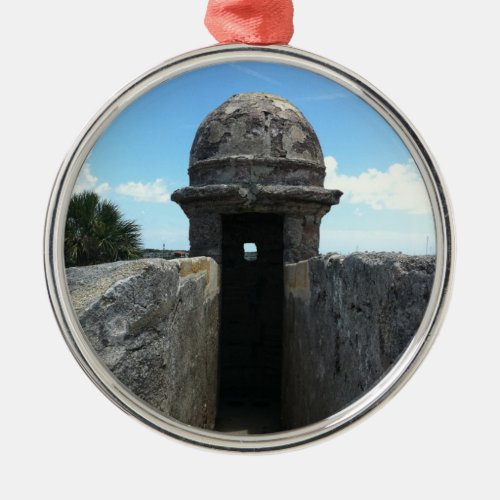Castillo de San Marcos Turret, St. Augustine, FL Metal Ornament



The Castillo de San Marcos site is the oldest masonry fort in the United States. It is located in the city of St. Augustine, Florida. Construction was begun in 1672 by the Spanish when Florida was a Spanish territory. During the twenty year period of British possession from 1763 until 1784, the fort was renamed Fort St. Mark, and after Florida became a U.S. territory in 1821 the fort was again renamed Fort Marion, in honor of revolutionary war hero Francis Marion. In 1942 the original name, Castillo de San Marcos, was restored by Congress. The site was never taken by force despite multiple periods of attack. The European city of St. Augustine was founded by the admiral Pedro Menéndez de Avilés for the Spanish Crown in 1565 on the site of a former Native American village. Over the next 100 years, the Spanish built nine wooden forts for the defense of the town in various locations. The need for fortifications was recognized after it was attacked by Sir Francis Drake and his fleet of 20 ships in 1586. Following the 1668 attack of the English pirate Robert Searle, Mariana Queen Regent of Spain, approved the construction of a masonry fortification to protect the city. The Castillo is a masonry star fort made of a stone called coquina, Spanish for "small shells", made of ancient shells that have bonded together to form a type of stone similar to limestone. Workers were brought in from Havana, Cuba, to construct the fort in addition to Native American laborers. The coquina was quarried from the 'King's Quarry' on Anastasia Island in what is today Anastasia State Park across Matanzas Bay from the Castillo, and ferried across to the construction site. Construction began on October 2, 1672 and lasted twenty-three years, with completion in 1695. The barrels of cannons deployed on the terreplein project outward through multiple embrasures located along the curtain wall between San Pedro and San AgustÃn bastions and on San AgustÃn bastion (visible on right), below is the sallyport — the only entrance to the fort. The fort has four bastions named San Pedro, San AgustÃn, San Carlos and San Pablo with a ravelin protecting the sally port. On the two landward sides a large glacis was constructed which would force any attackers to advance upward toward the fort's cannon and allow the cannon shot to proceed downslope for greater efficiency in hitting multiple targets. Immediately surrounding the fort was a moat which could be flooded to a depth of a foot during high-tide with seawater from Matanzas Bay prior to an attack via the use of floodgates built into the seawall. Multiple embrasures were built into the curtain wall along the top of the fort as well as into the bastions for the deployment of cannon of various calibers. Infantry embrasures were also built into the walls below the level of the terreplein for the deployment of muskets by the fort's defenders. It was through one of these embrasures that twenty Seminoles held as prisoners would escape in 1837. http://en.wikipedia.org/wiki/Castillo_de_San_Marcos


